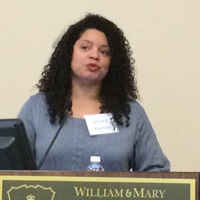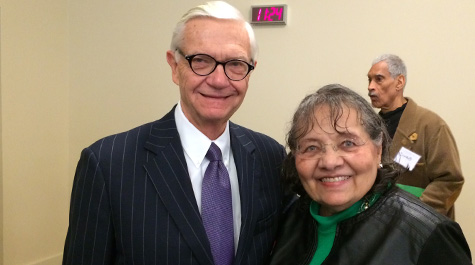Nash infuses Lemon Project audience with agapic energy
Diane Nash informed her audience at the sixth annual Lemon Project spring symposium on Saturday that there are six steps to effecting social change employing “agapic energy” – love for one’s fellow man.
Nash would know. Taught the philosophy of non-violence by James Lawson, who learned it studying Mohandas Gandhi while serving as a missionary in India, Nash coined the phrase agapic energy and employed it in the 1960s to spearhead several of the most successful civil-rights campaigns in American history.
Speaking at William & Mary’s School of Education, Nash recounted her efforts in the first successful strategy to integrate lunch counters in Nashville, Tennessee; her alliance with the Freedom Riders, who desegregated interstate travel; her co-founding of the Student Nonviolent Coordinating Committee (SNCC) and her co-coordination of the Selma Voting Rights Amendment, a precursor to the Voting Rights Act of 1965.
“She has changed the course of history; she continues to change the course of history,” Shana Haines, a Ph.D. student in history at W&M, said in introducing Nash.
Before Nash spoke, W&M President Taylor Reveley presented the audience with a brief overview of the Lemon Project, named for a slave the university owned in the 18th century.
“In the spring of 2009, the campus community decided it was time for William & Mary to come to grips with its racial past in a more serious way than ever before,” Reveley said.
To that end, he referenced the university’s Task Force on Race and Race Relations – an important element in W&M’s focus on race on campus today – which has met monthly for the last year and is preparing a report that examines events closely related to race on campus and throughout the nation.
Nash was just 22 when she took charge of the Nashville lunch counter sit-ins. At the time, African Americans could order lunch from certain establishments on a take-out basis only. Nash and her friends and followers targeted six restaurants and employed the following method of desegregating them: investigation, education, negotiation, demonstration, resistance, and prevention of reoccurrence.
During the investigation phase, Nash and her colleagues agreed on a specific objective and wrote it down.
“You gather any information to you to have to accomplish the objective, and you identify exactly how the oppressed are participating in their oppression,” she said.
Next came the education of the cause’s followers on what was learned during the investigation, followed by negotiation.
“You make your opponent understand your objective,” Nash said. “You let them know that you respect them, but will not tolerate their behavior.”
In Nashville, one restaurant owner said he didn’t serve blacks at his counter because he was afraid he would lose his white business. So Nash arranged with local churches that, for three weeks, “sophisticated white ladies” would sit next to blacks at the man’s lunch counter. She knew, she said, that after three weeks, the media would report that peaceful desegregation was taking place.
Following the negotiation phase was demonstration, with the aim to “show the public the purpose of your objective,” Nash said.
The next step, resistance, was where “the oppressed withdrew their participation in the oppression,” said Nash, adding that it could take many forms – work stoppages and refusal to pay taxes, among them.
The final step was to prevent the problem from reoccurring.
“Often, young people are more vulnerable to a rollback of their civil rights,” Nash said. Among the methods of minimizing that possibility are the creation of museums, educational foundations and documentary films that examine the problem and how it was solved.
Using agapic energy is not easy, Nash cautioned.
“Freedom is not something you do once and then you’ve got it. It’s a struggle, and every generation faces its own challenges," she said.
“The Freedom Riders, for example, made many sacrifices, whether it was violence or time in jail.”
Nash herself was jailed numerous times, once for 30 days despite the fact that she was four months pregnant.
Nash described the current climate in the country as “frightening,” and decried that “often people read and talk about what should be done, but never actually do anything.” Relying on government officials to improve matters doesn’t work because one of America’s problems is “government officials who will not govern,” said Nash.
“The movement of the 1960s can be used in 2016,” she said. “We now know that it works. We have an opportunity to move a step higher, to evolve to a higher stage. But American citizens have to take the country into their own hands.”
















